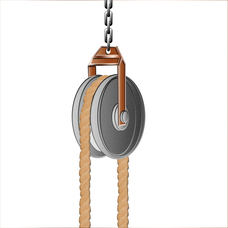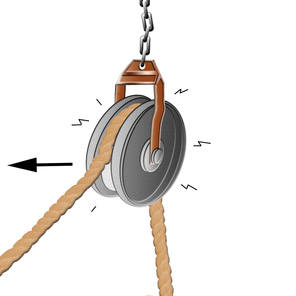Why do I have pain?
This is perhaps not surprisingly, the most common question I'm asked by the people I treat, and the answer is not necessarily what you might think...
The reality is that the above are simply names given to the end result of multiple dysfunctions that will not show on scans or x-rays or blood tests.
Pain Explained
Often times when I am working with someone who has severe low back pain, they cannot understand why just bending to pick up a pencil or get the washing out of the machine or to pick up their child, has left them in agonising back pain.
I will tell them about thresholds (explained later), about sitting, about posture and muscle imbalance. The same factors are involved whether you have low back pain, shoulder pain, calf pain or neck pain etc.
Movement by Design
To help understand why we get pain we need to start at the beginning. Humans were designed by nature, to stand on two legs. Nature tends not to make mistakes. The common suggestion that we get back pain because we should be walking on all four limbs is mistaken, for the following reasons…
A human being was designed and honed over millions of years to become a hunter-gatherer. Every aspect of our lives should involve being on the move, walking, gathering, running, and hunting. Even when resting, we should be in the dynamic balance of resting on our haunches (comfortably squatting with our knees fully bent and our butts resting on our heels). We should be sleeping in the darkness, then waking with the dawn to begin again, always moving because our very survival depended on our ability to move. Peaks of adrenaline as we run for our lives from hunters more ferocious than us, and again to give us power and speed as we chase the prey that will feed us for another day. Taking only what nature intended, not worrying about tomorrow or yesterday. Just content when we are warm, dry and full, we lived in the moment, as every other creature on the planet still does, save human beings.
Rise of Farming and technical innovation leads to Decrease in Movement
But around 10,000 years ago we learned to farm… With farming came a reduction in movement, we no longer had to follow game or forage with the seasons, no more moving to fresh pastures as we finished utilizing one, leaving it to renew until we passed the following season.
Our eating habits changed, as did our physical habits. Mans inventiveness has allowed him to work and move less and less, and in the last 10,000 years we have moved from strong, vibrant hunter gatherers in tune with the very earth and flow of nature, to desk bound, car bound, settee bound inanimate lumps of flesh and bone. But somewhere, deep within us there is still the call to hunt and gather, to move…
So we build gyms and run in circles, push weights, swim up and down, even as we invent more ways not to move. From remote controls to ease the burden of changing tv channels, to escalators so we don’t have to lift our feet in front of one another.
Streams and Ponds...
You will have noticed that the theme here is movement. Life is movement. Picture a running stream, cascading through mountain and meadow, clear and vibrant, teeming with life. The sparkle of sunshine catching on every ripple, every splash and wave. Stones and pebbles constantly tumbling beneath it, nothing ever the same in any moment. This is life, this is movement. They are synonymous.
Now imagine a body of still water, a pond perhaps. See the fetid air above it humming with parasites, whose eggs will only grow in the still, green scum on the surface, see the grey pallor of the water and the sludge gradually building up at the bottom, harbouring toxic detritus, breeding bacteria. This is what happens when there is no movement.
Disease and ill health can only begin where there is little or no movement. If you never lift your arms above you head, the fluid aspects of joint material in your shoulders will become ponds. If you eat stodgy chemical laden white bread and other processed foods your colon will become a pond. If you sit down all day, your muscles become ponds.
From the age of 5 we learn to sit 6 hours a day at a desk on a little plastic chair. Before that we learn from our parents how to slump in sofas. We come home from school and slump in chairs. Worse, we spend hours slumped at computers. Then we get desk jobs slumping all day, with constant stress tightening our muscles. Compounding that, we get a job miles from home, and drive in a fixed slumped position for hours each week. But it is still suggested that the reason we get back pain, is because nature made a mistake, and that we should walk on all fours…
Destructive Stillness?
No, the reason we get back pain is because for most of our lives we sit, we are sedentary. Even if you do a manual job, the chances are that you went to school. 11 years of your life were spent at a desk. Over the years you’ve travelled for hours on planes, trains and in cars. You’ve literally spent maybe years of your life watching television!
Every time you sit, especially if you slump, you are stretching and weakening your back muscles. You are shortening and tightening the muscles at the front of your body. The weakened immobile muscles in your back become little ponds, there is a build up of toxins, the waste products of muscle activity. These toxins build up because there is no movement. This irritates the muscles further: imagine sitting naked in a pile of your own poo. That’s what your muscles are doing! Becoming just as irritated as your bare skin would! They will go into a reactive spasm if you ask too much of them. They may also spasm if you do too little, as the lack of movement allows waste to build up in the inactive muscle. The old treatment for back pain, of lying on a hard bed for six weeks, just let all those waste products build up around those naked muscle cells and people eventually recovered despite the treatment.
But this (the deterioration of muscles) doesn’t happen all in one go. It takes a fair amount of time for muscles to get into this state, the body is always doing its best to maintain optimum function, you will have had various aches and pains along the way, this is the body’s attempt at warning you all is not as it should be. So if you are doing something that is detrimental to the body’s function it will warn you with pain, usually, early on this is just an ache, and if you continue to offend it, it will adjust or compensate and work in a slightly different way that causes no pain. It will allow some muscles to shorten and others to lengthen. Then when this causes some discomfort and you don’t change, it will adapt and compensate again. Bit by bit some muscles shorten and others lengthen and weaken. Eventually, sooner or later, we reach the straw breaking the camels back scenario. Quite simply a threshold is reached. A muscle has reached the limits of its endurance and compensation, it will go into a reactive spasm as you bend to pick up the pencil. This can be extraordinarily painful on it’s own, but if the muscle goes into a full blown cramp you could be incapacitated!
Pullys and Ropes and Wear and Tear


Only in this respect is a machine like a human body. A human joint will not wear because you do a lot of running or sport. It will wear because your muscles are pulling on it asymmetrically when you do sport.
Sleeping on your stomach with your head to one side or your arm above your head.
Twisting at your work station to look at an inappropriately placed monitor.
Movement Illuminates Dysfunctional areas
I emphatically believe that activity is rarely the cause of painful structure symptoms. It merely highlights them. I will only ever encourage someone to stop moving if there is damage that will be aggravated by movement.
In most cases the sedentary nature of our lives from childhood will create many potential ‘ponds’ around our bodies. These are mostly areas of dysfunctional, tight muscles. When we run, or play tennis, or go to the gym to work out, we may get pain, not because of the activity, but because our dysfunctional muscles aren’t up to the job we are asking of them.
It would be quite natural to reduce the activity or stop it, as our doctor often suggests. After all we don’t get pain sitting at our desks do we? But the reality is that we need to address the reasons for pain when we move, not stop the movement.
.